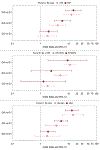Prediction of Sudden Cardiac Death Manifesting With Documented Ventricular Fibrillation or Pulseless Ventricular Tachycardia
- PMID: 35450595
- PMCID: PMC9034059
- DOI: 10.1016/j.jacep.2022.02.004
Prediction of Sudden Cardiac Death Manifesting With Documented Ventricular Fibrillation or Pulseless Ventricular Tachycardia
Abstract
Objectives: This study aimed to develop a novel clinical prediction algorithm for avertable sudden cardiac death.
Background: Sudden cardiac death manifests as ventricular fibrillation (VF)/ ventricular tachycardia (VT) potentially treatable with defibrillation, or nonshockable rhythms (pulseless electrical activity/asystole) with low likelihood of survival. There are no available clinical risk scores for targeted prediction of VF/VT.
Methods: Subjects with out-of-hospital sudden cardiac arrest presenting with documented VF or pulseless VT (33% of total cases) were ascertained prospectively from the Portland, Oregon, metro area with population ≈1 million residents (n = 1,374, 2002-2019). Comparisons of lifetime clinical records were conducted with a control group (n = 1,600) with ≈70% coronary disease prevalence. Prediction models were constructed from a training dataset using backwards stepwise logistic regression and applied to an internal validation dataset. Receiver operating characteristic curves (C statistic) were used to evaluate model discrimination. External validation was performed in a separate, geographically distinct population (Ventura County, California, population ≈850,000, 2015-2020).
Results: A clinical algorithm (VFRisk) constructed with 13 clinical, electrocardiogram, and echocardiographic variables had very good discrimination in the training dataset (C statistic = 0.808; [95% CI: 0.774-0.842]) and was successfully validated in internal (C statistic = 0.776 [95% CI: 0.725-0.827]) and external (C statistic = 0.782 [95% CI: 0.718-0.846]) datasets. The algorithm substantially outperformed the left ventricular ejection fraction (LVEF) ≤35% (C statistic = 0.638) and performed well across the LVEF spectrum.
Conclusions: An algorithm for prediction of sudden cardiac arrest manifesting with VF/VT was successfully constructed using widely available clinical and noninvasive markers. These findings have potential to enhance primary prevention, especially in patients with mid-range or preserved LVEF.
Keywords: cardiac arrest; prevention; risk stratification; sudden cardiac death; ventricular fibrillation.
Copyright © 2022 American College of Cardiology Foundation. Published by Elsevier Inc. All rights reserved.
Conflict of interest statement
Funding Support and Author Disclosures Dr Chugh has received funding from National Institutes of Health, National Heart, Lung, and Blood Institute Grants R01HL126938 and R01HL145675 for this work; and holds the Pauline and Harold Price Chair in Cardiac Electrophysiology at Cedars-Sinai, Los Angeles. All other authors have reported that they have no relationships relevant to the contents of this paper to disclose.
Figures





Comment in
-
Prediction of Fatal or Near-Fatal Cardiac Arrhythmias: Where Are We Now?JACC Clin Electrophysiol. 2022 Apr;8(4):424-425. doi: 10.1016/j.jacep.2022.02.007. JACC Clin Electrophysiol. 2022. PMID: 35450596 No abstract available.
Similar articles
-
Artificial Intelligence Model Predicts Sudden Cardiac Arrest Manifesting With Pulseless Electric Activity Versus Ventricular Fibrillation.Circ Arrhythm Electrophysiol. 2024 Feb;17(2):e012338. doi: 10.1161/CIRCEP.123.012338. Epub 2024 Jan 29. Circ Arrhythm Electrophysiol. 2024. PMID: 38284289 Free PMC article.
-
Temporal Trends in Incidence and Survival From Sudden Cardiac Arrest Manifesting With Shockable and Nonshockable Rhythms: A 16-Year Prospective Study in a Large US Community.Ann Emerg Med. 2023 Oct;82(4):463-471. doi: 10.1016/j.annemergmed.2023.04.001. Epub 2023 May 18. Ann Emerg Med. 2023. PMID: 37204349 Free PMC article.
-
Antiarrhythmic Drugs for Nonshockable-Turned-Shockable Out-of-Hospital Cardiac Arrest: The ALPS Study (Amiodarone, Lidocaine, or Placebo).Circulation. 2017 Nov 28;136(22):2119-2131. doi: 10.1161/CIRCULATIONAHA.117.028624. Epub 2017 Sep 13. Circulation. 2017. PMID: 28904070 Free PMC article. Clinical Trial.
-
Implantable cardioverter defibrillator for prevention of sudden cardiac death in patients with ventricular tachycardia and ventricular fibrillation: ICD therapy in sudden cardiac death.Pacing Clin Electrophysiol. 1993 Mar;16(3 Pt 2):511-8. doi: 10.1111/j.1540-8159.1993.tb01618.x. Pacing Clin Electrophysiol. 1993. PMID: 7681950 Review.
-
Epidemiology of ventricular tachyarrhythmia : Any changes in the past decades?Herzschrittmacherther Elektrophysiol. 2017 Jun;28(2):143-148. doi: 10.1007/s00399-017-0503-5. Epub 2017 May 8. Herzschrittmacherther Elektrophysiol. 2017. PMID: 28484840 Review. English.
Cited by
-
Dynamic electrocardiogram changes are a novel risk marker for sudden cardiac death.Eur Heart J. 2024 Mar 7;45(10):809-819. doi: 10.1093/eurheartj/ehad770. Eur Heart J. 2024. PMID: 37956651 Free PMC article.
-
Rare Genetic Variants Associated With Sudden Cardiac Arrest in the Young: A Prospective, Population-Based Study.Circ Genom Precis Med. 2023 Aug;16(4):404-405. doi: 10.1161/CIRCGEN.123.004105. Epub 2023 May 17. Circ Genom Precis Med. 2023. PMID: 37194601 Free PMC article. No abstract available.
-
Risk Factors for Sudden Cardiac Arrest Among Hispanic or Latino Adults in Southern California: Ventura PRESTO and HCHS/SOL.J Am Heart Assoc. 2023 Oct 17;12(20):e030062. doi: 10.1161/JAHA.123.030062. Epub 2023 Oct 11. J Am Heart Assoc. 2023. PMID: 37818701 Free PMC article.
-
Prediction of sudden cardiac death using artificial intelligence: Current status and future directions.Heart Rhythm. 2025 Mar;22(3):756-766. doi: 10.1016/j.hrthm.2024.09.003. Epub 2024 Sep 6. Heart Rhythm. 2025. PMID: 39245250 Free PMC article. Review.
-
Artificial Intelligence Model Predicts Sudden Cardiac Arrest Manifesting With Pulseless Electric Activity Versus Ventricular Fibrillation.Circ Arrhythm Electrophysiol. 2024 Feb;17(2):e012338. doi: 10.1161/CIRCEP.123.012338. Epub 2024 Jan 29. Circ Arrhythm Electrophysiol. 2024. PMID: 38284289 Free PMC article.
References
-
- Virani SS, Alonso A, Aparicio HJ et al. Heart Disease and Stroke Statistics-2021 Update: A Report From the American Heart Association. Circulation 2021;143:e254–e743. - PubMed
-
- Myerburg RJ, Halperin H, Egan DA et al. Pulseless electric activity: definition, causes, mechanisms, management, and research priorities for the next decade: report from a National Heart, Lung, and Blood Institute workshop. Circulation 2013;128:2532–41. - PubMed
-
- Cobb LA, Fahrenbruch CE, Olsufka M, Copass MK. Changing incidence of out-of-hospital ventricular fibrillation, 1980–2000. Jama 2002;288:3008–13. - PubMed
-
- Bardy GH, Lee KL, Mark DB et al. Amiodarone or an implantable cardioverter-defibrillator for congestive heart failure. N Engl J Med 2005;352:225–37. - PubMed
-
- Moss AJ, Zareba W, Jackson Hall W et al. Prophylactic implantation of a defibrillator in patients with myocardial infarction and reduced ejection fraction. New England Journal of Medicine 2002;346:877–883. - PubMed
Publication types
MeSH terms
Grants and funding
LinkOut - more resources
Full Text Sources

